rear NISSAN 370Z COUPE 2016 Z34 Owners Manual
[x] Cancel search | Manufacturer: NISSAN, Model Year: 2016, Model line: 370Z COUPE, Model: NISSAN 370Z COUPE 2016 Z34Pages: 428, PDF Size: 3.01 MB
Page 401 of 428
![NISSAN 370Z COUPE 2016 Z34 Owners Manual 9-10Technical and consumer information
Tire
TypeSize Pressure PSI (kPa) [Cold]
Conventional Front: 225/50R18 95W
Rear: 245/45R18 96W
35 (240)*2
38 (260)*3
Front: 245/40R19 94W
Rear: 275/35R19 96W 32 ( NISSAN 370Z COUPE 2016 Z34 Owners Manual 9-10Technical and consumer information
Tire
TypeSize Pressure PSI (kPa) [Cold]
Conventional Front: 225/50R18 95W
Rear: 245/45R18 96W
35 (240)*2
38 (260)*3
Front: 245/40R19 94W
Rear: 275/35R19 96W 32 (](/img/5/465/w960_465-400.png)
9-10Technical and consumer information
Tire
TypeSize Pressure PSI (kPa) [Cold]
Conventional Front: 225/50R18 95W
Rear: 245/45R18 96W
35 (240)*2
38 (260)*3
Front: 245/40R19 94W
Rear: 275/35R19 96W 32 (220)
NISMO models Front: 245/40R19 98Y
Rear: 285/35R19 99Y 35 (240)
Spare (T-type) T145/80D17 107M*1
T145/70R18 107M*1
60 (420)
—*3, *4
*1: if so equipped
*2: Coupe models
*3: Roadster models
*4: The emergency tire puncture repair kit is supplied.
DIMENSIONS
in (mm)
Overall length 167.6 (4,255)*1 167.7 (4,260)*2
170.5 (4,330)*3
Overall width 72.6 (1,845) 73.6 (1,870)*3
Overall height 51.8 (1,315) 52.2 (1,325)*4
Front tread 61.0 (1,550)*5
60.6 (1,540)*6
61.2 (1,555)*6, *3
Rear tread 62.8 (1,595)*5
61.6 (1,565)*6
62.2 (1,580)*6, *3
Wheelbase 100.4 (2,550)
*1: Without front license plate bracket
*2: With front license plate bracket
*3: NISMO models
*4: Roadster models
*5: 18-inch wheel models
*6: 19-inch wheel models
Page 409 of 428
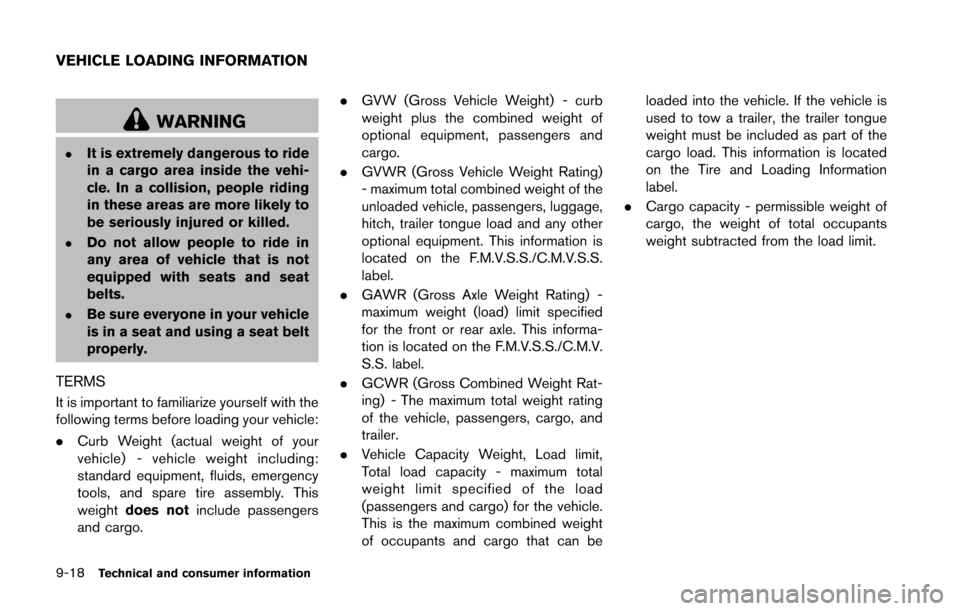
9-18Technical and consumer information
WARNING
.It is extremely dangerous to ride
in a cargo area inside the vehi-
cle. In a collision, people riding
in these areas are more likely to
be seriously injured or killed.
.Do not allow people to ride in
any area of vehicle that is not
equipped with seats and seat
belts.
.Be sure everyone in your vehicle
is in a seat and using a seat belt
properly.
TERMS
It is important to familiarize yourself with the
following terms before loading your vehicle:
.Curb Weight (actual weight of your
vehicle) - vehicle weight including:
standard equipment, fluids, emergency
tools, and spare tire assembly. This
weight does not include passengers
and cargo. .
GVW (Gross Vehicle Weight) - curb
weight plus the combined weight of
optional equipment, passengers and
cargo.
. GVWR (Gross Vehicle Weight Rating)
- maximum total combined weight of the
unloaded vehicle, passengers, luggage,
hitch, trailer tongue load and any other
optional equipment. This information is
located on the F.M.V.S.S./C.M.V.S.S.
label.
. GAWR (Gross Axle Weight Rating) -
maximum weight (load) limit specified
for the front or rear axle. This informa-
tion is located on the F.M.V.S.S./C.M.V.
S.S. label.
. GCWR (Gross Combined Weight Rat-
ing) - The maximum total weight rating
of the vehicle, passengers, cargo, and
trailer.
. Vehicle Capacity Weight, Load limit,
Total load capacity - maximum total
weight limit specified of the load
(passengers and cargo) for the vehicle.
This is the maximum combined weight
of occupants and cargo that can be loaded into the vehicle. If the vehicle is
used to tow a trailer, the trailer tongue
weight must be included as part of the
cargo load. This information is located
on the Tire and Loading Information
label.
. Cargo capacity - permissible weight of
cargo, the weight of total occupants
weight subtracted from the load limit.
VEHICLE LOADING INFORMATION
Page 411 of 428
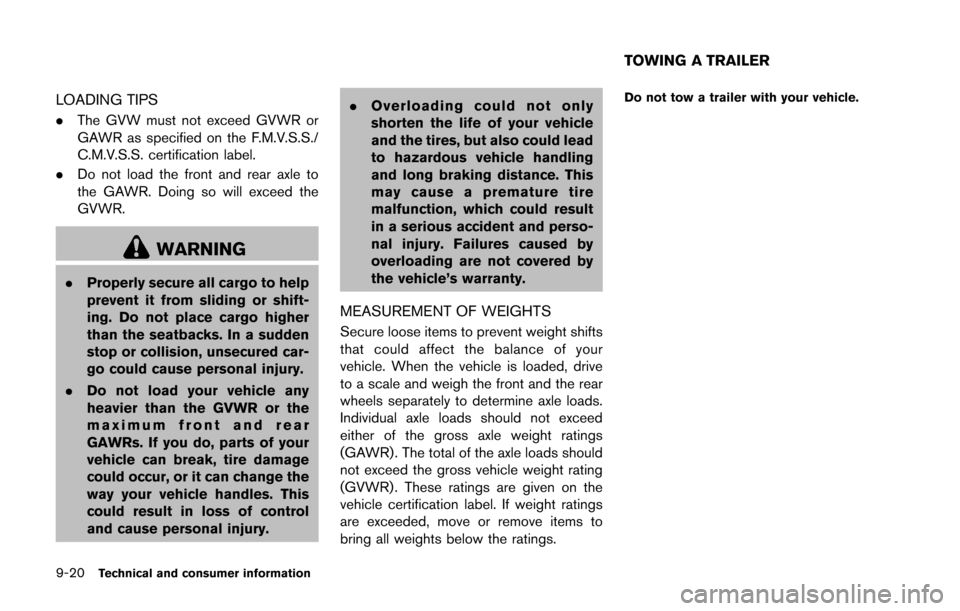
9-20Technical and consumer information
LOADING TIPS
.The GVW must not exceed GVWR or
GAWR as specified on the F.M.V.S.S./
C.M.V.S.S. certification label.
. Do not load the front and rear axle to
the GAWR. Doing so will exceed the
GVWR.
WARNING
.Properly secure all cargo to help
prevent it from sliding or shift-
ing. Do not place cargo higher
than the seatbacks. In a sudden
stop or collision, unsecured car-
go could cause personal injury.
. Do not load your vehicle any
heavier than the GVWR or the
maximum front and rear
GAWRs. If you do, parts of your
vehicle can break, tire damage
could occur, or it can change the
way your vehicle handles. This
could result in loss of control
and cause personal injury. .
Overloading could not only
shorten the life of your vehicle
and the tires, but also could lead
to hazardous vehicle handling
and long braking distance. This
may cause a premature tire
malfunction, which could result
in a serious accident and perso-
nal injury. Failures caused by
overloading are not covered by
the vehicle’s warranty.
MEASUREMENT OF WEIGHTS
Secure loose items to prevent weight shifts
that could affect the balance of your
vehicle. When the vehicle is loaded, drive
to a scale and weigh the front and the rear
wheels separately to determine axle loads.
Individual axle loads should not exceed
either of the gross axle weight ratings
(GAWR) . The total of the axle loads should
not exceed the gross vehicle weight rating
(GVWR) . These ratings are given on the
vehicle certification label. If weight ratings
are exceeded, move or remove items to
bring all weights below the ratings.
Do not tow a trailer with your vehicle.
TOWING A TRAILER
Page 421 of 428
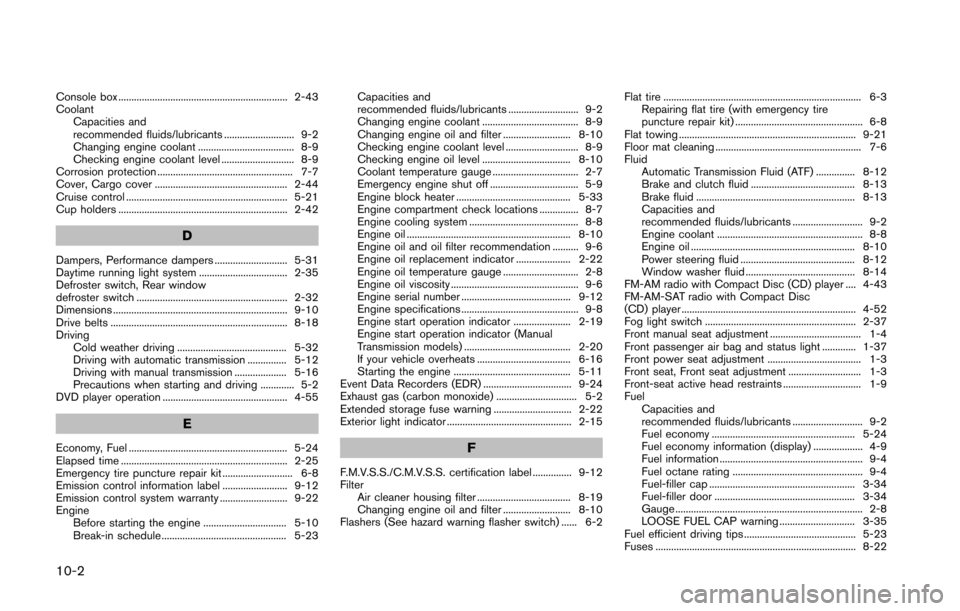
10-2
Console box ................................................................. 2-43
CoolantCapacities and
recommended fluids/lubricants ........................... 9-2
Changing engine coolant ..................................... 8-9
Checking engine coolant level ............................ 8-9
Corrosion protection .................................................... 7-7
Cover, Cargo cover ................................................... 2-44
Cruise control .............................................................. 5-21
Cup holders ................................................................. 2-42
D
Dampers, Performance dampers ............................ 5-31
Daytime running light system .................................. 2-35
Defroster switch, Rear window
defroster switch .......................................................... 2-32
Dimensions ................................................................... 9-10
Drive belts .................................................................... 8-18
Driving Cold weather driving .......................................... 5-32
Driving with automatic transmission ............... 5-12
Driving with manual transmission .................... 5-16
Precautions when starting and driving ............. 5-2
DVD player operation ................................................ 4-55
E
Economy, Fuel ............................................................. 5-24
Elapsed time ................................................................ 2-25
Emergency tire puncture repair kit ........................... 6-8
Emission control information label ......................... 9-12
Emission control system warranty .......................... 9-22
Engine Before starting the engine ................................ 5-10
Break-in schedule ................................................ 5-23 Capacities and
recommended fluids/lubricants ........................... 9-2
Changing engine coolant ..................................... 8-9
Changing engine oil and filter .......................... 8-10
Checking engine coolant level ............................ 8-9
Checking engine oil level .................................. 8-10
Coolant temperature gauge ................................. 2-7
Emergency engine shut off .................................. 5-9
Engine block heater ............................................ 5-33
Engine compartment check locations ............... 8-7
Engine cooling system .......................................... 8-8
Engine oil ............................................................... 8-10
Engine oil and oil filter recommendation .......... 9-6
Engine oil replacement indicator ..................... 2-22
Engine oil temperature gauge ............................. 2-8
Engine oil viscosity ................................................. 9-6
Engine serial number .......................................... 9-12
Engine specifications ............................................. 9-8
Engine start operation indicator ...................... 2-19
Engine start operation indicator (Manual
Transmission models) ......................................... 2-20
If your vehicle overheats .................................... 6-16
Starting the engine ............................................. 5-11
Event Data Recorders (EDR) .................................. 9-24
Exhaust gas (carbon monoxide) ............................... 5-2
Extended storage fuse warning .............................. 2-22
Exterior light indicator ................................................ 2-15F
F.M.V.S.S./C.M.V.S.S. certification label ............... 9-12
Filter Air cleaner housing filter .................................... 8-19
Changing engine oil and filter .......................... 8-10
Flashers (See hazard warning flasher switch) ...... 6-2 Flat tire ............................................................................ 6-3
Repairing flat tire (with emergency tire
puncture repair kit) ................................................. 6-8
Flat towing .................................................................... 9-21
Floor mat cleaning ........................................................ 7-6
Fluid Automatic Transmission Fluid (ATF) ............... 8-12
Brake and clutch fluid ........................................ 8-13
Brake fluid ............................................................. 8-13
Capacities and
recommended fluids/lubricants ........................... 9-2
Engine coolant ........................................................ 8-8
Engine oil ............................................................... 8-10
Power steering fluid ............................................ 8-12
Window washer fluid .......................................... 8-14
FM-AM radio with Compact Disc (CD) player .... 4-43
FM-AM-SAT radio with Compact Disc
(CD) player ................................................................... 4-52
Fog light switch .......................................................... 2-37
Front manual seat adjustment ................................... 1-4
Front passenger air bag and status light ............. 1-37
Front power seat adjustment .................................... 1-3
Front seat, Front seat adjustment ............................ 1-3
Front-seat active head restraints .............................. 1-9
Fuel Capacities and
recommended fluids/lubricants ........................... 9-2
Fuel economy ....................................................... 5-24
Fuel economy information (display) ................... 4-9
Fuel information ....................................................... 9-4
Fuel octane rating .................................................. 9-4
Fuel-filler cap ........................................................ 3-34
Fuel-filler door ...................................................... 3-34
Gauge ........................................................................ 2-8
LOOSE FUEL CAP warning ............................. 3-35
Fuel efficient driving tips ........................................... 5-23
Fuses ............................................................................. 8-22
Page 422 of 428
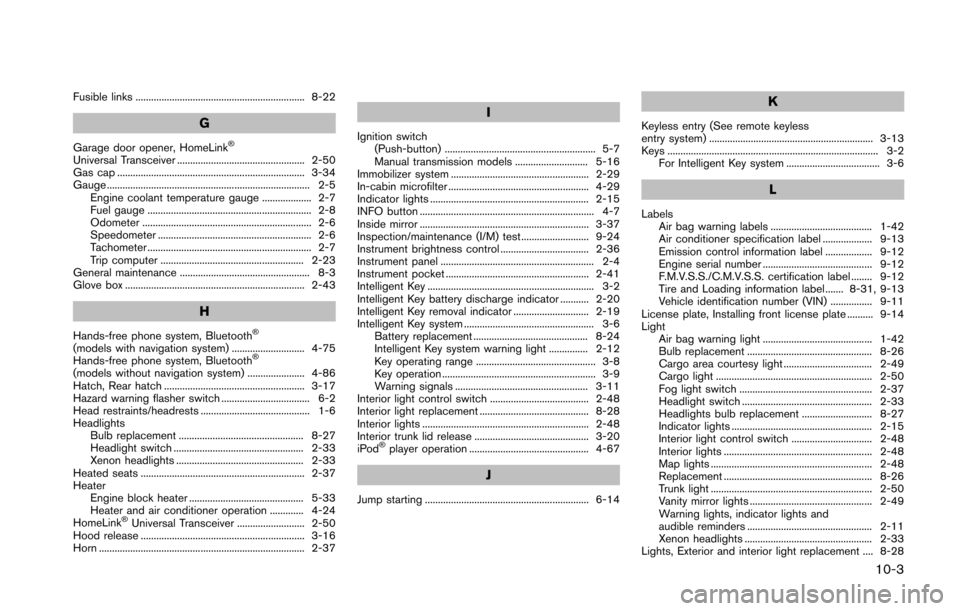
Fusible links ................................................................. 8-22
G
Garage door opener, HomeLink�Š
Universal Transceiver ................................................. 2-50
Gas cap ........................................................................ 3-34
Gauge .............................................................................. 2-5Engine coolant temperature gauge ................... 2-7
Fuel gauge ............................................................... 2-8
Odometer ................................................................. 2-6
Speedometer ........................................................... 2-6
Tachometer ............................................................... 2-7
Trip computer ....................................................... 2-23
General maintenance .................................................. 8-3
Glove box ..................................................................... 2-43
H
Hands-free phone system, Bluetooth�Š
(models with navigation system) ............................ 4-75
Hands-free phone system, Bluetooth�Š
(models without navigation system) ...................... 4-86
Hatch, Rear hatch ...................................................... 3-17
Hazard warning flasher switch .................................. 6-2
Head restraints/headrests .......................................... 1-6
Headlights Bulb replacement ................................................ 8-27
Headlight switch .................................................. 2-33
Xenon headlights ................................................. 2-33
Heated seats ............................................................... 2-37
Heater Engine block heater ............................................ 5-33
Heater and air conditioner operation ............. 4-24
HomeLink
�ŠUniversal Transceiver .......................... 2-50
Hood release ............................................................... 3-16
Horn ............................................................................... 2-37
I
Ignition switch (Push-button) .......................................................... 5-7
Manual transmission models ............................ 5-16
Immobilizer system ..................................................... 2-29
In-cabin microfilter ...................................................... 4-29
Indicator lights ............................................................. 2-15
INFO button ................................................................... 4-7
Inside mirror ................................................................. 3-37
Inspection/maintenance (I/M) test .......................... 9-24
Instrument brightness control .................................. 2-36
Instrument panel ........................................................... 2-4
Instrument pocket ....................................................... 2-41
Intelligent Key ................................................................ 3-2
Intelligent Key battery discharge indicator ........... 2-20
Intelligent Key removal indicator ............................. 2-19
Intelligent Key system .................................................. 3-6 Battery replacement ............................................ 8-24
Intelligent Key system warning light ............... 2-12
Key operating range .............................................. 3-8
Key operation ........................................................... 3-9
Warning signals ................................................... 3-11
Interior light control switch ...................................... 2-48
Interior light replacement .......................................... 8-28
Interior lights ................................................................ 2-48
Interior trunk lid release ............................................ 3-20
iPod
�Šplayer operation .............................................. 4-67
J
Jump starting ............................................................... 6-14
K
Keyless entry (See remote keyless
entry system) ............................................................... 3-13
Keys ................................................................................. 3-2 For Intelligent Key system .................................... 3-6
L
LabelsAir bag warning labels ....................................... 1-42
Air conditioner specification label ................... 9-13
Emission control information label .................. 9-12
Engine serial number .......................................... 9-12
F.M.V.S.S./C.M.V.S.S. certification label ........ 9-12
Tire and Loading information label ....... 8-31, 9-13
Vehicle identification number (VIN) ................ 9-11
License plate, Installing front license plate .......... 9-14
Light Air bag warning light .......................................... 1-42
Bulb replacement ................................................ 8-26
Cargo area courtesy light .................................. 2-49
Cargo light ............................................................ 2-50
Fog light switch ................................................... 2-37
Headlight switch .................................................. 2-33
Headlights bulb replacement ........................... 8-27
Indicator lights ...................................................... 2-15
Interior light control switch ............................... 2-48
Interior lights ......................................................... 2-48
Map lights .............................................................. 2-48
Replacement ......................................................... 8-26
Trunk light .............................................................. 2-50
Vanity mirror lights ............................................... 2-49
Warning lights, indicator lights and
audible reminders ................................................ 2-11
Xenon headlights ................................................. 2-33
Lights, Exterior and interior light replacement .... 8-28
10-3
Page 423 of 428
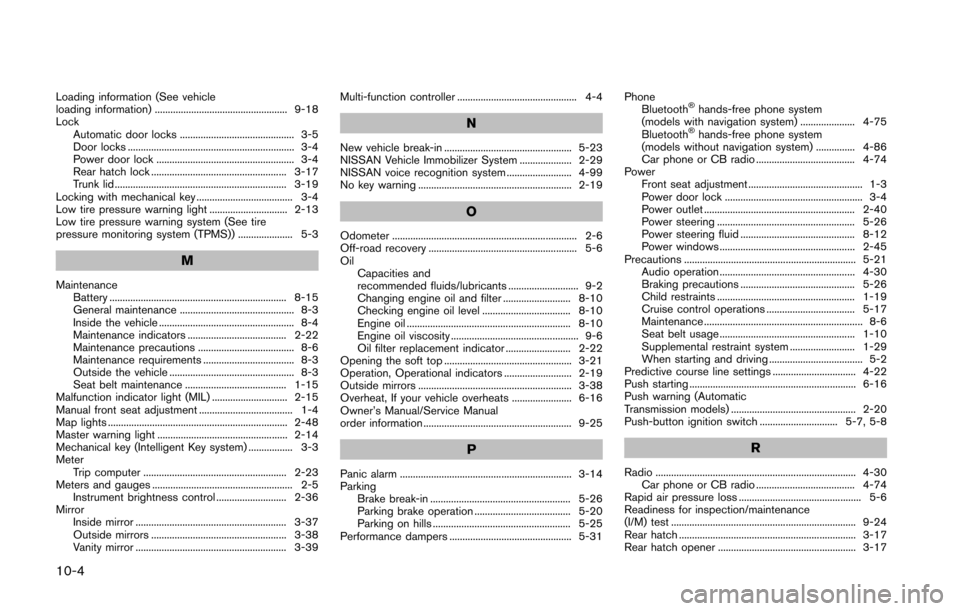
10-4
Loading information (See vehicle
loading information) ................................................... 9-18
LockAutomatic door locks ............................................ 3-5
Door locks ................................................................ 3-4
Power door lock ..................................................... 3-4
Rear hatch lock .................................................... 3-17
Trunk lid .................................................................. 3-19
Locking with mechanical key ..................................... 3-4
Low tire pressure warning light .............................. 2-13
Low tire pressure warning system (See tire
pressure monitoring system (TPMS)) ..................... 5-3
M
Maintenance Battery .................................................................... 8-15
General maintenance ............................................ 8-3
Inside the vehicle .................................................... 8-4
Maintenance indicators ...................................... 2-22
Maintenance precautions ..................................... 8-6
Maintenance requirements ................................... 8-3
Outside the vehicle ................................................ 8-3
Seat belt maintenance ....................................... 1-15
Malfunction indicator light (MIL) ............................. 2-15
Manual front seat adjustment .................................... 1-4
Map lights ..................................................................... 2-48
Master warning light .................................................. 2-14
Mechanical key (Intelligent Key system) ................. 3-3
Meter Trip computer ....................................................... 2-23
Meters and gauges ...................................................... 2-5 Instrument brightness control ........................... 2-36
Mirror Inside mirror .......................................................... 3-37
Outside mirrors .................................................... 3-38
Vanity mirror .......................................................... 3-39 Multi-function controller .............................................. 4-4
N
New vehicle break-in ................................................. 5-23
NISSAN Vehicle Immobilizer System .................... 2-29
NISSAN voice recognition system ......................... 4-99
No key warning ........................................................... 2-19
O
Odometer ....................................................................... 2-6
Off-road recovery ......................................................... 5-6
Oil
Capacities and
recommended fluids/lubricants ........................... 9-2
Changing engine oil and filter .......................... 8-10
Checking engine oil level .................................. 8-10
Engine oil ............................................................... 8-10
Engine oil viscosity ................................................. 9-6
Oil filter replacement indicator ......................... 2-22
Opening the soft top ................................................. 3-21
Operation, Operational indicators .......................... 2-19
Outside mirrors ........................................................... 3-38
Overheat, If your vehicle overheats ....................... 6-16
Owner’s Manual/Service Manual
order information ......................................................... 9-25
P
Panic alarm .................................................................. 3-14
Parking Brake break-in ...................................................... 5-26
Parking brake operation ..................................... 5-20
Parking on hills ..................................................... 5-25
Performance dampers ............................................... 5-31 Phone
Bluetooth
�Šhands-free phone system
(models with navigation system) ..................... 4-75
Bluetooth
�Šhands-free phone system
(models without navigation system) ............... 4-86
Car phone or CB radio ...................................... 4-74
Power Front seat adjustment ............................................ 1-3
Power door lock ..................................................... 3-4
Power outlet .......................................................... 2-40
Power steering ..................................................... 5-26
Power steering fluid ............................................ 8-12
Power windows .................................................... 2-45
Precautions .................................................................. 5-21 Audio operation .................................................... 4-30
Braking precautions ............................................ 5-26
Child restraints ..................................................... 1-19
Cruise control operations .................................. 5-17
Maintenance ............................................................. 8-6
Seat belt usage .................................................... 1-10
Supplemental restraint system ......................... 1-29
When starting and driving .................................... 5-2
Predictive course line settings ................................ 4-22
Push starting ................................................................ 6-16
Push warning (Automatic
Transmission models) ................................................ 2-20
Push-button ignition switch .............................. 5-7, 5-8
R
Radio ............................................................................. 4-30 Car phone or CB radio ...................................... 4-74
Rapid air pressure loss ............................................... 5-6
Readiness for inspection/maintenance
(I/M) test ....................................................................... 9-24
Rear hatch .................................................................... 3-17
Rear hatch opener ..................................................... 3-17
Page 424 of 428
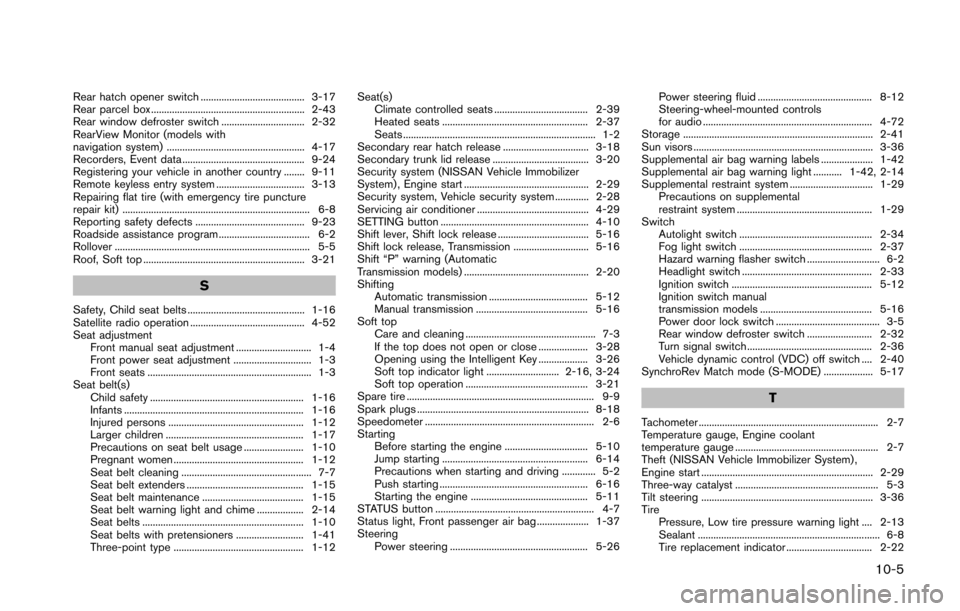
Rear hatch opener switch ........................................ 3-17
Rear parcel box ........................................................... 2-43
Rear window defroster switch ................................ 2-32
RearView Monitor (models with
navigation system) ..................................................... 4-17
Recorders, Event data ............................................... 9-24
Registering your vehicle in another country ........ 9-11
Remote keyless entry system .................................. 3-13
Repairing flat tire (with emergency tire puncture
repair kit) ........................................................................ 6-8
Reporting safety defects .......................................... 9-23
Roadside assistance program ................................... 6-2
Rollover ........................................................................... 5-5
Roof, Soft top .............................................................. 3-21
S
Safety, Child seat belts ............................................. 1-16
Satellite radio operation ............................................ 4-52
Seat adjustmentFront manual seat adjustment ............................. 1-4
Front power seat adjustment .............................. 1-3
Front seats ............................................................... 1-3
Seat belt(s) Child safety ........................................................... 1-16
Infants ..................................................................... 1-16
Injured persons .................................................... 1-12
Larger children ..................................................... 1-17
Precautions on seat belt usage ....................... 1-10
Pregnant women .................................................. 1-12
Seat belt cleaning .................................................. 7-7
Seat belt extenders ............................................. 1-15
Seat belt maintenance ....................................... 1-15
Seat belt warning light and chime .................. 2-14
Seat belts .............................................................. 1-10
Seat belts with pretensioners .......................... 1-41
Three-point type .................................................. 1-12 Seat(s)
Climate controlled seats .................................... 2-39
Heated seats ........................................................ 2-37
Seats .......................................................................... 1-2
Secondary rear hatch release ................................. 3-18
Secondary trunk lid release ..................................... 3-20
Security system (NISSAN Vehicle Immobilizer
System) , Engine start ................................................ 2-29
Security system, Vehicle security system ............. 2-28
Servicing air conditioner ........................................... 4-29
SETTING button ......................................................... 4-10
Shift lever, Shift lock release ................................... 5-16
Shift lock release, Transmission ............................. 5-16
Shift “P” warning (Automatic
Transmission models) ................................................ 2-20
Shifting Automatic transmission ...................................... 5-12
Manual transmission ........................................... 5-16
Soft top Care and cleaning .................................................. 7-3
If the top does not open or close ................... 3-28
Opening using the Intelligent Key ................... 3-26
Soft top indicator light ............................ 2-16, 3-24
Soft top operation ............................................... 3-21
Spare tire ........................................................................ 9-9
Spark plugs .................................................................. 8-18
Speedometer ................................................................. 2-6
Starting Before starting the engine ................................ 5-10
Jump starting ........................................................ 6-14
Precautions when starting and driving ............. 5-2
Push starting ......................................................... 6-16
Starting the engine ............................................. 5-11
STATUS button ............................................................. 4-7
Status light, Front passenger air bag .................... 1-37
Steering Power steering ..................................................... 5-26 Power steering fluid ............................................ 8-12
Steering-wheel-mounted controls
for audio ................................................................. 4-72
Storage ......................................................................... 2-41
Sun visors ..................................................................... 3-36
Supplemental air bag warning labels .................... 1-42
Supplemental air bag warning light ........... 1-42, 2-14
Supplemental restraint system ................................ 1-29 Precautions on supplemental
restraint system .................................................... 1-29
Switch Autolight switch ................................................... 2-34
Fog light switch ................................................... 2-37
Hazard warning flasher switch ............................ 6-2
Headlight switch .................................................. 2-33
Ignition switch ...................................................... 5-12
Ignition switch manual
transmission models ........................................... 5-16
Power door lock switch ........................................ 3-5
Rear window defroster switch ......................... 2-32
Turn signal switch ................................................ 2-36
Vehicle dynamic control (VDC) off switch .... 2-40
SynchroRev Match mode (S-MODE) ................... 5-17
T
Tachometer ..................................................................... 2-7
Temperature gauge, Engine coolant
temperature gauge ....................................................... 2-7
Theft (NISSAN Vehicle Immobilizer System) ,
Engine start .................................................................. 2-29
Three-way catalyst ....................................................... 5-3
Tilt steering .................................................................. 3-36
Tire Pressure, Low tire pressure warning light .... 2-13
Sealant ...................................................................... 6-8
Tire replacement indicator ................................. 2-22
10-5